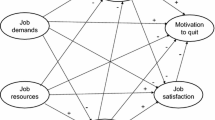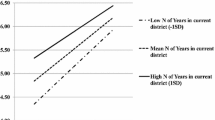Abstract
Structural equation modeling was used to examine a conceptual model specifying hypothesized linkages among teachers’ perceptions of school organizational factors, including classroom context and role stress, and commitment, satisfaction, and intentions to leave. Respondents to survey questions designed to capture the above constructs included 177 teachers in seven high schools in a southern coastal region of California. Structural equation modeling results indicated that all three study predictors (class size, student behavior, and role stress) affected intentions to leave, and satisfaction and commitment mediated the relationship between the school organizational factors and intentions to leave.


Similar content being viewed by others
References
Arbuckle, J. L. (1996). Full information estimation in the presence of incomplete data. In G. A. Marcoulides & R. E. Schumaker (Eds.), Advanced structural equation modeling: Issues and techniques (pp. 243–278). Mahweh: Lawrence Erlbaum.
Arbuckle, J. L. (2003). AMOS 5.0 [computer software]. Chicago: SPSS.
Beehr, T. A. (1995). Psychological stress in the workplace. London: Routledge.
Beehr, T. A., Walsh, J. T., & Taber, T. D. (1976). Relationship of stress to individually and organizationally valued states: Higher order needs as a moderator. Journal of Applied Psychology, 61, 41–47.
Bentler, P. M. (1990). Comparative fit indexes in structural models. Psychological Bulletin, 107(2), 238–246.
Bentler, P. M., & Bonett, D. G. (1980). Significance tests and goodness of fit in the analysis of covariance structures. Psychological Bulletin, 88, 588–606.
Bentler, P. M., & Chou, C. (1987). Practical issues in structural equation modeling. Sociological Methods and Research, 16, 78–117.
Bluedorn, A. C. (1982). A unified model of turnover from organizations. Human Relations, 35, 135–153.
Collinson, V. (1996). Reaching students: Teachers’ ways of knowing. Thousand Oaks: Corwin.
Collinson, V. (2013). Teacher-principal collaboration: Partnerships or power plays? In S. Conley & B. S. Cooper (Eds.), Moving from teacher isolation to collaboration (pp. 183–201). Lanham: Rowman & Littlefield.
Conley, S., Bacharach, S. & Bauer, S. (1989). The school work environment and teacher career dissatisfaction. Educational Administration Quarterly, 25(1), 58–81.
Conley, S. & You, S. (2009). Teacher role stress, satisfaction, commitment, and intent to leave: A structural model. Psychological Reports, 105, 771–786.
Conley, S. & You, S. (2014). Role stress revisited: Job structuring antecedents, work outcomes, and moderating effects of locus of control. Educational Management Administration & Leadership, 42(2), 184–206. https://doi.org/10.1177/1741143213499264.
Conley, S., & You, S. (2017). Key influences on special education teachers’ intentions to leave: The effects of administrative support and teacher team efficacy in a mediational model. Educational Management Administration & Leadership, 45(3), 521–540. https://doi.org/10.1177/1741143215608859.
Dee, J. R., Henkin, A. B., & Singleton, C. A. (2006). Organizational commitment of teachers in urban schools: Examining the effects of team structures. Urban Education, 41(6), 603–627.
Ding, L., Velicer, W. F., & Harlow, L. L. (1995). Effects of estimation methods, number of indicators per factor, and improper solutions on structural equation modeling fit indices. Structural Equation Modeling: A Multidisciplinary Journal, 2, 119–143.
Elangovan, A. R. (2001). Causal ordering of stress, satisfaction and commitment, and intention to quit: A structural equations analysis. Leadership and Organization Development Journal, 22(4), 159–165.
Firestone, W. (1996). Images of teaching and proposals for reform: A comparison of ideas from cognitive and organizational research. Educational Administration Quarterly, 32, 209–235.
George, N. L., George, M. P., Gersten, R., & Growenick, J. R. (1995). To leave or to stay? An exploratory study of teachers of students with emotional and behavioral disorders. Remedial and Special Education, 16, 227–236.
Gersten, R., Keating, T., Yovanoff, P., & Harniss, M. K. (2001). Working in special education: Factors that enhance special educators' intent to stay. Exceptional Children, 67(4), 549–567.
Hu, L., & Bentler, P. M. (1999). Cutoff criteria for fit indexes in covariance structure analysis: Conventional criteria versus new alternatives. Structural Equation Modeling: A Multidisciplinary Journal, 6, 1–55.
Ingersoll, R., Merrill, L. & May, H. (2014). What are the effects of teacher education and preparation on beginning teacher attrition? Research Report (RR#82). Philadelphia: Consortium for Policy Research in Education, University of Pennsylvania.
Jackson, S. E., & Schuler, R. S. (1985). A meta-analysis and conceptual critique of research on role ambiguity and role conflict in work settings. Organizational Behavior and Human Decision Processes, 36, 16–78.
Kline, R. B. (1998). Principles and practice of structural equation modeling. NY: Guilford Press.
Koustelios, A., & Kousteliou, I. (1998). Relations among measures of job satisfaction, role conflict, and role ambiguity for a sample of Greek teachers. Psychological Reports, 82, 131–136.
Lachman, R., & Diamant, E. (1987). Withdrawal and restraining factors in teachers’ turnover intentions. Journal of Occupational Behavior, 8, 219–232.
McDonald, R. P., & Ho, M.-H. R. (2002). Principles and practice in reporting structural equation analyses. Psychological Methods, 7(1), 64–82.
Mowday, R. T., Porter, L. W., & Steers, R. M. (1982). Employee-organization linkages: The psychology of commitment, absenteeism, and turnover. New York: Academic Press.
Perrachione, B. A., Petersen, G. J., & Rosser, V. J. (2008). Why do they stay? Elementary teachers' perceptions of job satisfaction and retention. The Professional Educator, 32(2).
Porter, L. W., Steers, R. M., Mowday, R. T., & Boulian, P. V. (1974). Organizational commitment, job satisfaction, and turnover among psychiatric technicians. Journal of Applied Psychology, 59(5), 603–609.
Reyes, P., & Imber, M. (1992). Teachers’ perceptions of the fairness of their workload and their commitment, job satisfaction, and morale: Implications for teacher evaluation. Journal of Personnel Evaluation in Education, 5, 291–301.
Rinke, C. R. (2008). Understanding teachers' careers: Linking professional life to professional path. Educational Research Review, 3(1), 1–13.
Rizzo, J. R., House, R. J., & Lirtzman, S. I. (1970). Role conflict and role ambiguity in complex organizations. Administrative Science Quarterly, 15, 150–163.
Rosenholtz, S. (1989). Teachers’ workplace: The social organization of schools. New York: Longman.
Rosenholtz, S. J. (1991). Teachers' workplace: The social organization of schools. New York: Teachers College Press.
Rosenholtz, S. J., & Simpson, C. (1990). Workplace conditions and the rise and fall of teachers' commitment. Sociology of Education, 63(4), 241–257.
Skaalvik, E. M., & Skaalvik, S. (2015). Job satisfaction, stress and coping strategies in the teaching profession--what do teachers say? International Education Studies, 8(3), 181–192.
Steiger, J. H., & Lind, J. M. (1980). Statistically based tests for the number of common factors. Paper presented at the Annual Spring Meeting of the Psychometric Society, Iowa City, IA.
Von der Embse, N. P., Pendergast, L. L., Segool, N., Saeki, E., et al. (2016). The influence of test-based accountability policies on school climate and teacher stress across four states. Teaching and Teacher Education, 59, 492–502.
Wayne, S. J., Shore, L. M., & Liden, R. C. (1997). Perceived organizational support and leader-member exchange: A social exchange perspective. Academy of Management Journal, 40(1), 82–111.
Williams, L. J., & Hazer, J. T. (1986). Antecedents and consequences of satisfaction and commitment in turnover models: A reanalysis using latent variable structural equation methods. Journal of Applied Psychology, 71(2), 219–231.
Funding
This work was partially supported by the Hankuk University of Foreign Studies Research Fund.
Author information
Authors and Affiliations
Corresponding author
Ethics declarations
Ethical Approval
All procedures performed in studies involving human participants were in accordance with the ethical standards of the institutional and/or national research committee and with the 1964 Helsinki declaration and its later amendments or comparable ethical standards.
Informed Consent
Informed consent was obtained from all individual participants included in the study.
Conflict of Interest
The authors declare that they have no conflicts of interest.
Appendix
Appendix
Rights and permissions
About this article
Cite this article
Conley, S., You, S. School organizational factors relating to teachers’ intentions to leave: A mediator model. Curr Psychol 40, 379–389 (2021). https://doi.org/10.1007/s12144-018-9953-0
Published:
Issue Date:
DOI: https://doi.org/10.1007/s12144-018-9953-0




